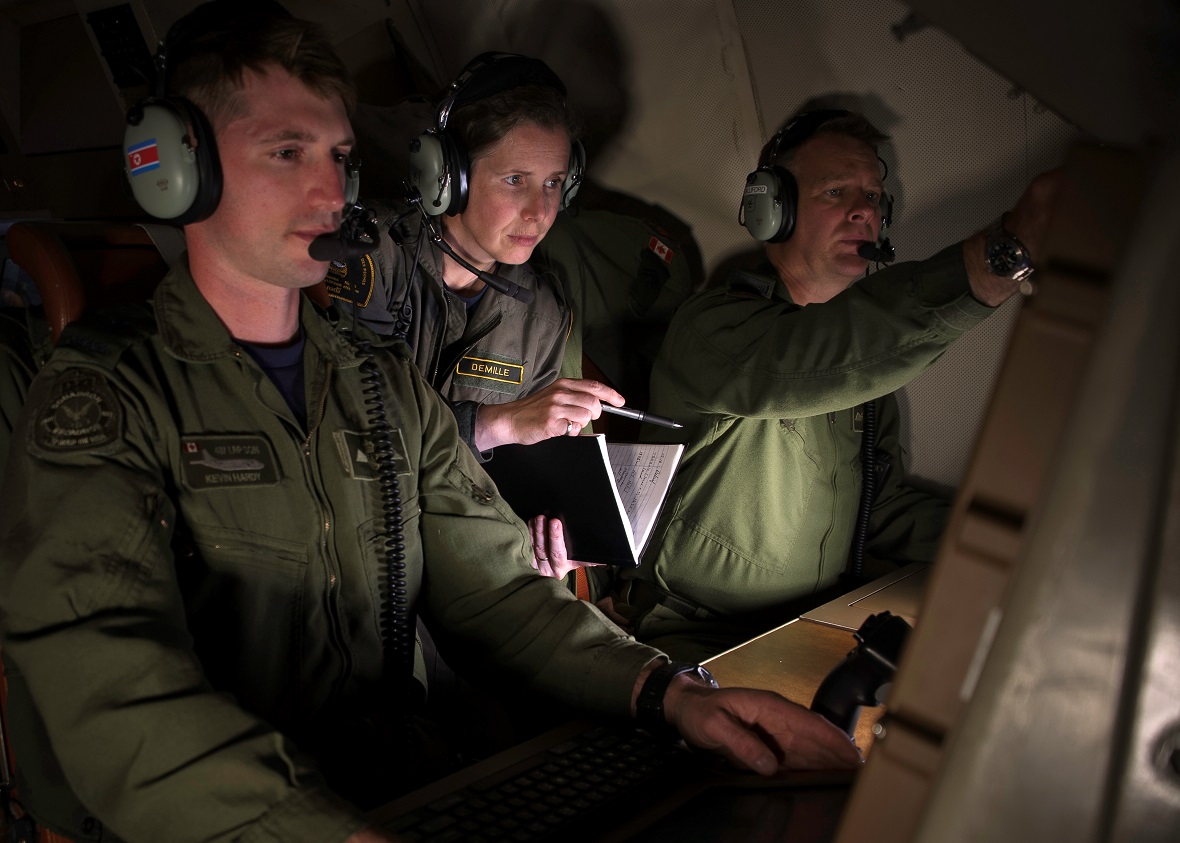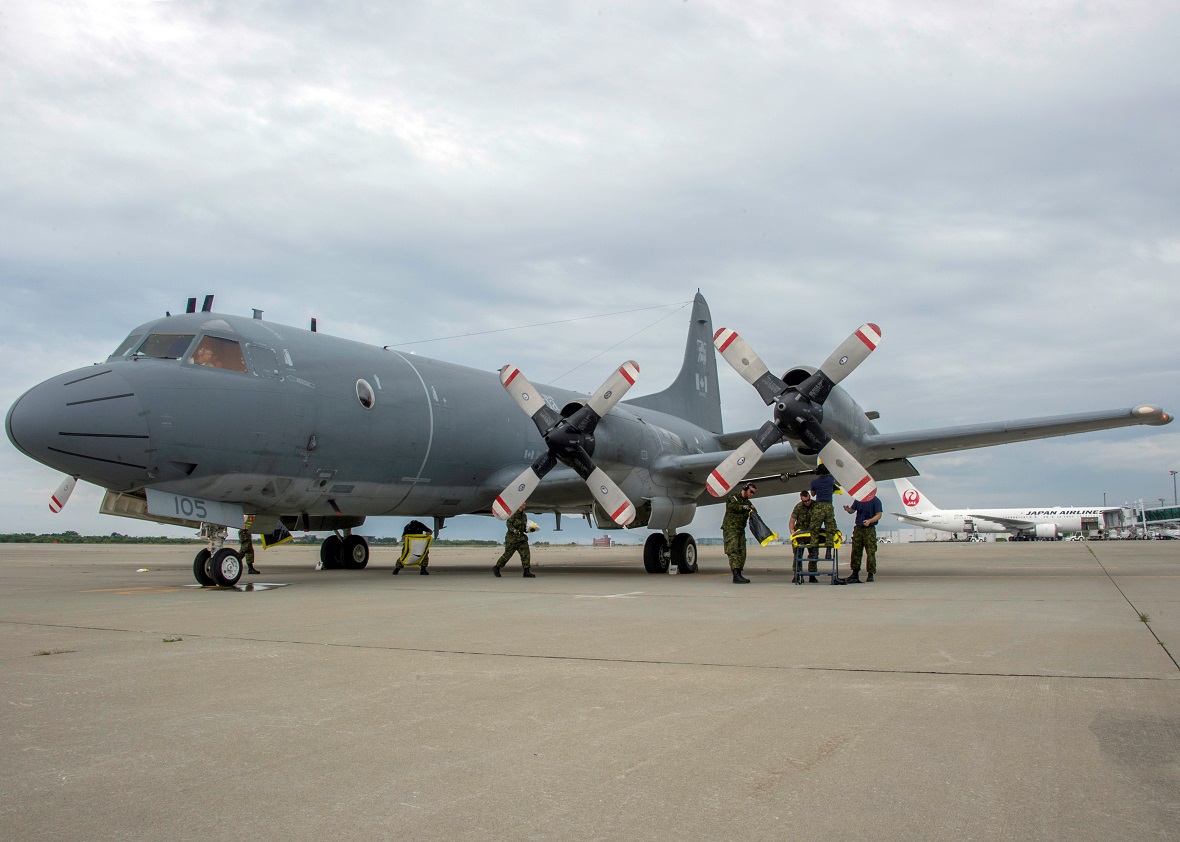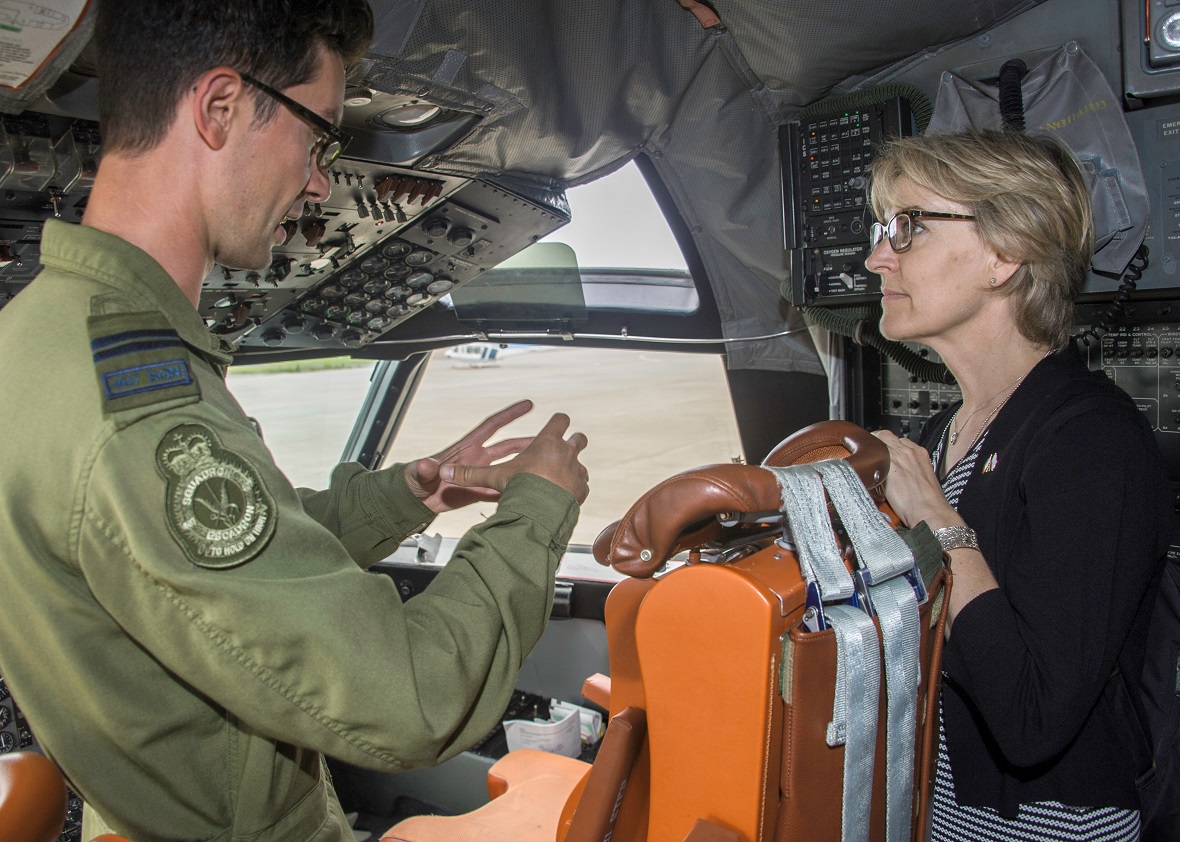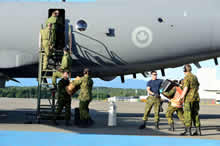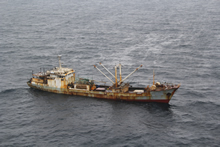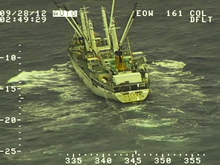Operation DRIFTNET
Operation DRIFTNET has been a regular Canadian Armed Forces (CAF) operation conducted in support of Fisheries and Oceans Canada (Department of Fisheries and Oceans) efforts to protect wild fish stocks world-wide from the threat of illegal, unreported and unregulated (IUU) fishing. This operation aims to support legitimate fish harvesters and to stop drift-netting and other illegal fishing practices.
Operation DRIFTNET took place under an agreement between the DFO and the Department of National Defence.
Update
There are no CAF assets deployed on this operation at this time.
About the operation: Video
Transcript for Op DRIFTNET Video
[Patricia Demille:] Illegal fishing activity takes fish from domestic markets that would be legally caught in normal fishing practices.
Operation DRIFTENT demonstrates how partner countries work together to curtail illegal, unreported or unregulated fishing activity.
Patricia Demille, Fishery Officer, Department of Fisheries and Oceans
The CP-140 Aurora aircraft has technical capabilities and a highly trained crew that are able to use sensors to detect any vessels of interest that are giving cues that they might be engaged in illegal activity.
That combined with its long-range capability makes it a valuable asset to this operation.
[Captain Louis St-Pierre:] The CP-140 is a perfect aircraft for Operation DRIFTNET, not just because of our range and sensors, but because of the infrastructure and training we provide to this operation.
Captain Louis St-Pierre, Crew Commander for the CP-140 Aurora Detachment, Op DRIFTNET
A typical day for us on Op DRIFTNET consists of getting our mission brief from DND (Department of National Defence) members and U.S. Coast Guard members based out of Juneau, Alaska. We liaise with the Department of Fisheries and Oceans to ensure their intents are met.
We get together as a crew, we brief our mission, we make sure our tactics are in good working order and that we’re all on the same page, we head out to the aircraft for pre-flight to make sure our sensors are in good working order, and then off we go.
[Patricia Demille:] My role in Operation DRIFTNET is to participate in all flight missions and to work with the sensor crew to identify any vessels of interest, and once a vessel of interest has been detected, there will be various sensors used to identify what type of fishing activity that vessel is engaged in.
Driftnet use is a highly destructive fishing practice. Driftnets can fish indiscriminately and destroy any fish species, marine mammals, or bird life that happen to get entrapped in the nets.
It’s estimated that illegal fishing can cause up to $23 billion a year in losses at all levels of the fishing industry.
These loses are significant to local economies.
Partnerships such as the Department of National Defence and the Department of Fisheries and Oceans combined with the deployment of surface assets such as the U.S. Coast Guard, work together cooperatively to provide a deterrent factor to anyone engaged in illegal activities. When they know we are out there, working together, they are much less inclined to conduct illegal activity.
[Captain Louis St-Pierre:] Working with the staff at the Hakodate Airport has been spectacular. They have been extremely helpful to us. They had everything set up before we got here. We are extremely grateful to them and everything they’ve done for us so far.
The work is really rewarding. It has been a real treat for us.
The task force
The Operation DRIFTNET task force is made up from the long-range maritime patrol squadrons of the Royal Canadian Air Force (RCAF), flying the CP-140 Aurora aircraft.
Fisheries and Oceans Canada officers, as well as United States Coast Guard (USCG) officers, travel on board the Auroras during such international fisheries patrols.
The Auroras patrol “high-threat” zones in the international waters of the North Pacific Ocean. They have electronic sensors that help them to see fishing boats. The DFO officials and the RCAF sensor operators look for signs of illegal fishing. They also gather photos for use as evidence to enforce the law.
Operation DRIFTNET also uses photos taken from space by Canadian satellites.
Mission context
The threat
High-seas drift netting is a fishing practice that harms the environment. It has been under a United Nations (UN) ban since December 1992.
Drift net fishing is a technique that uses large panels of netting. The nets are typically 10 to 15 metres wide and up to 20 kilometres long. They are fitted with floats and weights so they hang in the water. The nets drift in the currents and wind and catch fish and other wildlife that live in the ocean.
The nets were traditionally made of coarsely woven organic materials. This allowed small species and young fish to escape. Drift nets are now made of finely woven synthetic materials, such as nylon monofilament. This material has changed what is caught in the nets. The intended catch is usually mature salmon, tuna and swordfish. But today’s drift nets now also catch marine mammals, birds and turtles. They also ensnare large quantities of unwanted species and small fish that cannot be sold. These are considered "by-catch" and are often dead when the nets are taken up. The dead by-catch is dumped back in the ocean.
The mission
The first patrols of Operation DRIFTNET were flown in 1993.
Fishing in the international waters of the Pacific Ocean was not regulated until 1952. This is when the International Convention for the High-Seas Fisheries of the North Pacific came into force. It was arranged at the UN.
By 1989, drift net fishing was commonplace. Up to 2 million square miles of nets were set each year. The UN General Assembly passed three resolutions on drift net fishing between 1989 and 1991. Each was stricter than the last. The last of the series was Resolution 46/215 of December 20, 1991. It called on all countries to pass laws against large-scale surface drift net fishing in international waters by December 31, 1992.
In 1992 there was another change. The Convention for the Conservation of Anadromous Stocks in the North Pacific Ocean took place. It replaced the previous 1952 convention. The North Pacific Anadromous Fish Commission (NPAFC) was then formed.
Canada, Japan, the Russian Federation and the United States are charter members of the NPAFC. The Republic of Korea joined as a full member in 2003. The People's Republic of China became a non-member supporter in 2006. Member nations of the NPAFC work to detect and stop vessels that fish illegally in the North Pacific.
The results
Operation DRIFTNET is a part of Canada's NPAFC commitment. NPAFC monitors more than four million square kilometres of the North Pacific Ocean each year. When a NPAFC member spots and confirms illegal activity by a vessel, the ship's flag is identified. That nation is then responsible for prosecuting the violator.
Operation DRIFTNET patrols also deter potential illegal fishing, due to their presence.
Past missions
2019
2019
The most recent Operation DRIFTNET took place over two weeks in January 2019, and involved more than 20 personnel as part of a deployed Air Task Force: 12 CP-140 Aurora aircrew, six Aurora groundcrew, four mission support members, and officers from Fisheries and Oceans Canada and the United States Coast Guard’s District 14 Hawaii Pacific. During that deployment they flew seven assigned fisheries surveillance missions investigating vessels of interest, totalling 60 hours flown from their base in Nadi, Fiji. In those missions, the CP-140 Aurora and its combined team surveyed an area of approximately 1.3 million square kilometres in the Fijian Economic Exclusion Zone – as well as, in close coordination with the USCG high-endurance cutter Mellon, international waters around such Pacific island nations as Kiribati, Tokelau, Vanuatu and Tuvalu. Each Operation DRIFTNET involves teamwork between international partners, and in 2019 the team embarked aboard the Aurora and the USCG cutter Mellon worked and shared information with counterparts with the Fijian Ministry of Fisheries as well as the Pacific Islands Forum Fisheries Agency. In addition to ensuring that information about fishing activities was shared among all nations in that area of the Pacific, this latest DRIFTNET deployment demonstrated Canada’s involvement in this region of the world.
2017
2017
Operation DRIFTNET 2017, which aims to combat illegal fishing in the North Pacific, took place from July 5 to 29, 2017. Fisheries and Oceans Canada (DFO) officers and CAF members took part in this operation. They were supported by the United States Coast Guard out of Juneau, Alaska.
A CAF CP-140 Aurora long-range maritime patrol aircraft was stationed at Hakodate Airport, on Japan’s northern island of Hokkaido. This location allowed DFO officers flying on the CAF CP-140 to conduct surveillance patrols over the high-threat zone, which is beyond 322-kilometres from shore. Fishery officers and the Aurora sensor operators used the Aurora's electronic sensors to look for signs of illegal fishing and activity. They also used them to gather imagery to use as evidence in enforcement action.
2016
2016
Operation DRIFTNET 2016 took place from June 3 to 26, 2016.
RCAF personnel deployed from 407 Long Range Patrol Squadron stationed at Comox, B.C. to Hakodate, Japan. The operation was also supported by the United States Coast Guard out of Juneau, Alaska.
2015
2015
The CAF deployed one CP-140 Aurora aircraft and crew from 407 Long Range Patrol Squadron (Comox, BC) in support of DFO. The CAF members operated from Hakodate airfield in Hokkaido Prefecture (Japan) from June 6 to 28, 2015. They were supported by a RCAF CC-177 Globemaster III aircraft to transport personnel and equipment. The CP-140 Aurora completed two patrols. It flew a total of 12.5 hours.
The CAF visually investigated 14 fishing vessels during 2015 operations.
2014
2014
The CAF deployed one CP-140 Aurora aircraft and crew from 407 Long Range Patrol Squadron (Comox, BC), in support of DFO. They operated from Hakodate airfield in Hokkaido Prefecture (Japan) from May 11 to June 1, 2014. They were supported by a RCAF CC-177 Globemaster III aircraft to transport personnel and equipment. The CP-140 Aurora completed 11 patrols and flew a total of 108.1 hours.
One high seas drift netting vessel and two suspect vessels were detected. This made 2014 one of the most successful DRIFTNET deployments to date.
2013
2013
In support of DFO, the Canadian Armed Forces deployed one CP-140 Aurora aircraft and crew from 407 Long Range Patrol Squadron (Comox, BC). They operated from Hakodate, Hokkaido, Japan from August 17 to September 8, 2013. They were supported by a RCAF CC-177 Globemaster III aircraft to transport personnel and equipment. The CP-140 Aurora completed 9 patrols and flew a total of 116.2 hours.
2012
2012
Operation DRIFTNET 2012 ran from September 19 to October 6, 2012.
The CAF supported DFO to help protect fish stocks in 2012. One CP-140 aircraft and crew was sent from 407 Long Range Patrol Squadron out of Comox, BC. They flew patrols out of Hakodate, Japan. An RCAF CC-177 Globemaster III aircraft was also sent to carry personnel and equipment. The CP-140 Aurora flew a total of 88.4 hours on patrols.
Links
Government of Canada
International missions
Pertinent documents
News
There are currently no matching articles. Please check again later.
Page details
- Date modified:
